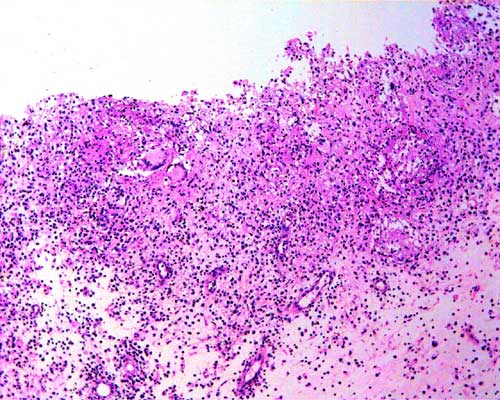We report two infants who presented with inflammatory thigh swelling in
first 6 months of life. BCG scar was seen over left upper arm in both.
Mantoux test, chest X-ray and family screening were normal in
both infants. Ultrasonography confirmed an intramuscular abscess in one
child and subcutaneous abscess in the others. Histopathology showed
granulomatous inflammation with caseous necrosis suggestive of
tuberculosis (Fig. 1). TB culture from the abscess
aspirate was positive only in one child. Surgical incision and drainage
was performed in both infants, followed by standard anti-tubercular
treatment for 6 months with full recovery. Both babies recovered
completely after standard treatment and were normal on follow-up till
18-24 months.
 |
|
Fig. 1 Abscess wall showing caseous
necrosis with epithelioid granulomas and giant cells. (See color
image at website)
|
Primary tuberculosis of skeletal muscle, first
described in 1886, is very rare [1]. Muscles are relatively resistant to
tuberculosis due to poor oxygen content and absence of
reticuloendothelial cell and lymphatic tissue [1]. Skeletal muscle and
subcutaneous tissue is usually affected by direct extension from
adjacent tissues. Primary involvement is commonly seen with an
underlying disorder, immunocompromised condition, local injury or by
direct inoculation [2]. BCG scar was present on left arm in both infants
ruling out erroneous BCG vaccination in the thigh [3].
They were given vitamin K and Hepatitis B vaccine in
thigh. It may be postulated that the intramuscular injection damages the
local tissue in some unknown way so that organisms, apparently dormant
elsewhere, lodge in these area of diminished resistance [4]. However,
the time required for soft tissue tuberculosis to evolve after primary
complex formation in lungs is usually in years, and presentation in
early infancy makes the pathogenesis unclear.
Hematogenous tuberculosis of muscle and subcutaneous
tissue is insidious in onset presenting as swelling with or without pain
often causing delay in diagnosis. Caseous necrosis with giant cell on
histopathology and/or positive tuberculous culture is diagnostic [1].
Differential diagnosis includes pyogenic abscess or injection swelling.
References
1. Katz R, Herman Ma, Katz S. Tuberculosis of muscle.
JAMA. 1964;190:472-3.
2. Agrawal A, Jain A. Tuberculous cold abscess.
Indian J Pediatr. 2007;74:771-3.
3. Al Namshan M, Oda O, Almaary J, Al Jadaan S,
Crankson S, Al Banyan E, et al. Bacillus Calmette-Guérin-related
cold thigh abscess as an unusual cause of thigh swelling in infants
following BCG vaccine administration: A case series. J Med Case Rep.
2011;5:472.
4. Glynn KP. Isolated subcutaneous abscesses caused by
Mycobacterium tuberculosis.Am Rev Resp Dis. 1969. p. 86-8.

